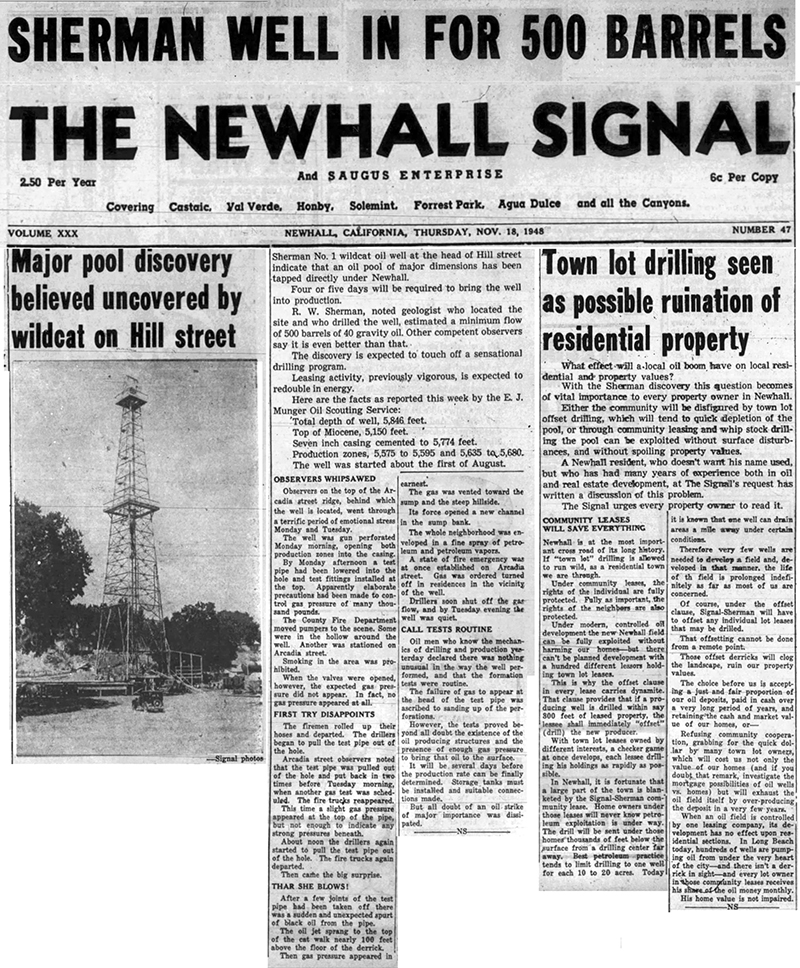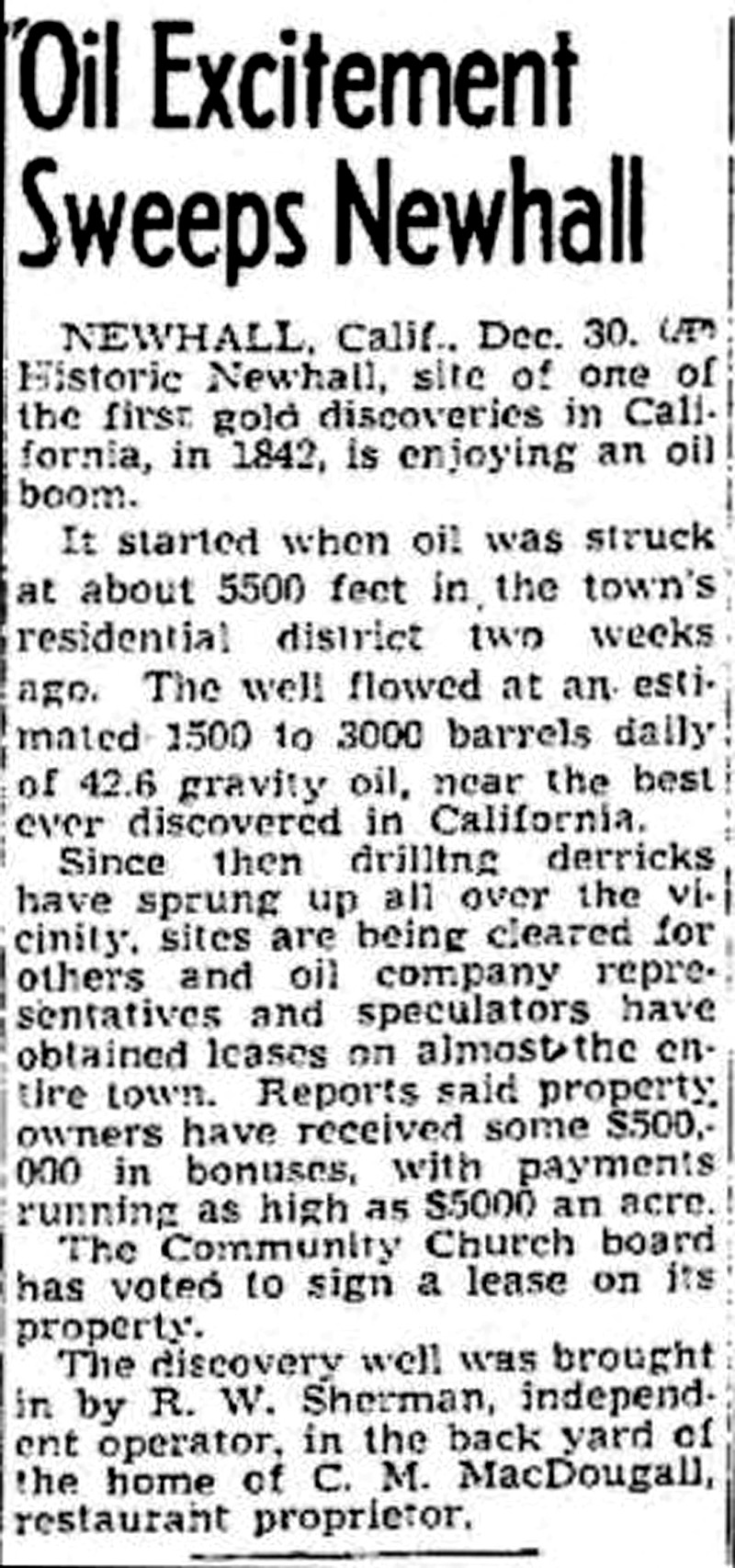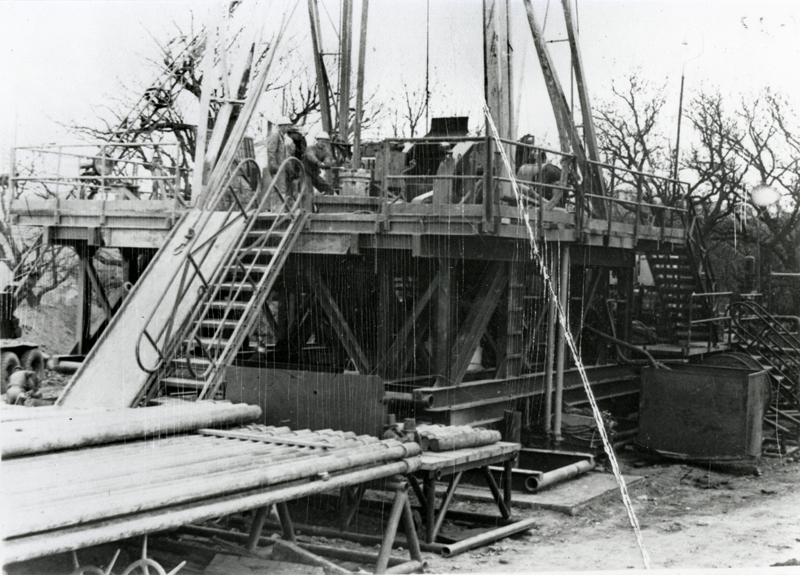|
|
Arcadia-Wayman Street Oil Boom of 1948-1949.
Starts in C.M. MacDougall's Backyard.
News Reports | 1948-1949.
|
Major Pool Discovery Believed Uncovered by Wildcat on Hill Street. The Newhall Signal and Saugus Enterprise | Thursday, November 18, 1948. Sherman No. 1 wildcat oil well at the head of Hill street indicate[s] that an oil pool of major dimensions has been tapped directly under Newhall. Four or five days will be required to bring the well into production. R.W. Sherman, noted geologist who located the site and who drilled the well, estimated a minimum flow of 500 barrels of 40 gravity oil. Other competent observers say it is even better than that. The discovery is expected to touch off a sensational drilling program. Leasing activity, previously vigorous, is expected to redouble in energy. Here are the facts as reported this week by the E.J. Munger Oil Scouting Service: Total depth of well, 5,846 feet. Top of Miocene, 5,150 feet. Seven-inch casing cemented to 5,774 feet. Production zones, 5,575 to 5,595 and 5,635 to 5,680. The well was started about the first of August. Observers Whipsawed. Observers on the top of the Arcadia street ridge, behind which the well is located, went through a terrific period of emotional stress Monday and Tuesday. The well was gun perforated Monday morning, opening both production zones into the casing. By Monday afternoon a test pipe had been lowered into the hole and test fittings installed at the top. Apparently elaborate precautions had been made to control gas pressure of many thousand pounds. The County Fire Department moved pumpers to the scene. Some were in the hollow around the well. Another was stationed on Arcadia street. Smoking in the area was prohibited. When the valves were opened, however, the expected gas pressure did not appear. In fact, no gas pressure appeared at all. First Try Disappoints. The firemen rolled up their hoses and departed. The drillers began to pull the test pipe out of the hole. Arcadia street observers noted that the test pipe was pulled out of the hole and put back in two times before Tuesday morning, when another gas test was scheduled. The fire trucks reappeared. This time a slight gas pressure appeared at the top of the pipe, but not enough to indicate any strong pressures beneath. About noon the drillers again started to pull the test pipe out of the hole. The fire trucks again departed. Then came the big surprise. Thar She Blows! After a few joints of the test pipe had been taken off, there was a sudden and unexpected spurt of black oil from the pipe. The oil jet sprang to the top of the cat walk nearly 100 feet above the floor of the derrick. Then gas pressure appeared in earnest. The gas was vented toward the sump and the steep hillside. Its force opened a new channel in the sump bank. The whole neighborhood was enveloped in a fine spray of petroleum and petroleum vapors. A state of fire emergency was at once established on Arcadia street. Gas was ordered turned off in residences in the vicinity of the well. Drillers soon shut off the gar flow, and by Tuesday evening the well was quiet. Call Tests Routine. Oil men who know the mechanics of drilling and production yesterday declared there was nothing unusual in the way the well performed, and that the formation tests were routine. The failure of gas to appear at the head of the test pipe was ascribed to sanding up of the perforations. However, the tests proved beyond all doubt the existence of the oil producing structures and the presence of enough gas pressure to bring that oil to the surface. It will be several days before the production rate can be finally determined. Storage tanks must be installed and suitable connections made. But all doubt of an oil strike of major importance was dissipated.
News story courtesy of Stan Walker.
Town Lot Drilling Seen as Possible Ruination of Residential Property. The Newhall Signal and Saugus Enterprise | Thursday, November 18, 1948. What effect will a local oil boom have on local residential and property values? With the Sherman discovery this question becomes of vital importance to every property owner in Newhall. Either the community will be disfigured by town lot offset drilling, which will tend to quick depletion of the pool, or through community leasing and whip stock drilling the pool can be exploited without surface disturbances, and without spoiling property values. A Newhall resident, who doesn't want his name used, but who has had many years of experience both in oil and real estate development, at The Signal's request has written a discussion of this problem. The Signal urges every property owner to read it. Community Leases Will Save Everything. Newhall is at the most important crossroad of its long history. If "town lot" drilling is allowed to run wild, as a residential town we are through. Under community leases, the rights of the individual are fully protected. Fully as important, the rights of the neighbors are also protected. Under modern, controlled oil development the new Newhall field can be fully exploited without harming our homes — but there can't be planned development with a hundred different lessors holding town lot leases. This is why the offset clause in every lease carries dynamite. That clause provides that if a producing well is drilled within say 300 feet of leased property, the lessee shall immediately "offset" (drill) the new producer. With town lot leases owned by different interests, a checker game at once develops, each lessee drilling his holdings as rapidly as possible. In Newhall, it is fortunate that a large part of the town is blanketed by the Signal-Sherman community lease. Home owners under those leases will never know petroleum exploitation is under way. The drill will be sent under those homes thousands of feet below the surface from a drilling center far away. Best petroleum practice tends to limit drilling to one well for each 10 to 20 acres. Today it is known that one well can drain areas a mile away under certain conditions. Therefore, very few wells are needed to develop a field and, developed in that manner, the life of the field is prolonged indefinitely as far as most of us are concerned. Of course, under the offset clause, Signal-Sherman will have to offset any individual lot leases that may be drilled. That offsetting cannot be done from a remote point. Those offset derricks will clog the landscape, ruin our property values. The choice before us is accepting a just and fair proportion of our oil deposits, paid in cash over a very long period of years, and retaining the cash and market value of our homes, or— Refusing community cooperation, grabbing for the quick dollar by many town lot owners, which will cost us not only the value of our homes (and if you doubt that remark, investigate the mortgage possibilities of oil wells vs. homes) but will exhaust the oil field itself by over-producing the deposit in a very few years. When an oil field is controlled by one leasing company, its development has no effect upon residential sections. In Long Beach today, hundreds of wells are pumping oil from under the very heart of the city — and there isn't a derrick in sight — and every lot owner in those community leases receives his share of the oil money monthly. His home value is not impaired.
According to Susan Davy (1-26-2017), daughter of Newhall pharmacist Ralph Williams, the oil well was located behind her parents' home at 1005 Arcadia St. (later renumbered 24445), on pasture land owned by Judge C.M. MacDougall, who lived at 929 Arcadia (renumbered 24335). It was after the fact, Davy writes, that her parents found out "oil wells were not to be drilled within 200 feet of a property line, and it was closer than that to our back fence. They also learned that Sherman used the "whipstock" method [aka "slant drilling"], meaning the drilling was going on under part of [our] family property. "The day the well gushered, the gas was turned off in area houses. Unfortunately, after several drilling attempts, Sherman could not get the salt water out of the oil, and he abandoned the drilling, leaving a sump hole in its place. There was such hysteria over possible oil being discovered, my mother couldn't keep strangers, carrying folding chairs, from walking onto the family property to sit and watch the drilling being done. She got so mad one day that she turned the garden hose on them."
|
The site owner makes no assertions as to ownership of any original copyrights to digitized images. However, these images are intended for Personal or Research use only. Any other kind of use, including but not limited to commercial or scholarly publication in any medium or format, public exhibition, or use online or in a web site, may be subject to additional restrictions including but not limited to the copyrights held by parties other than the site owner. USERS ARE SOLELY RESPONSIBLE for determining the existence of such rights and for obtaining any permissions and/or paying associated fees necessary for the proposed use.





